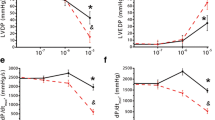The modulatory influence of diadenosine tetraphosphate (Ap4A) and diadenosine pentaphosphate (Ap5A) on the effect of intramural autonomic nerve stimulation in isolated rabbit sinoatrial node were examined. Electrical activity of the sinoatrial node was recorded intracellularly. Against the background of blockade of adrenergic effects with propranolol (3×10—6 M) or in preparations isolated 2 h after injection of reserpine (2 mg/kg), nerve stimulation induced short-term membrane hyperpolarization and diminished the sinus node firing rate. These phenomena were not affected by Ap4A or Ap5A (10—5 M). Under the action of atropine (3×10—6 M) that completely eliminated the cholinergic influences, nerve stimulation enhanced the sinus node firing rate by 17.30±3.45% from the initial rate. Both Ap4A and Ap5A moderated the stimulation-induced elevation of firing rate to 9.9±2.8 and 10.5±2.9%, respectively. The data suggest that diadenosine polyphosphates significantly modulate the sympathetic influences on the heart rhythm, but have no effect on the parasympathetic control over activity of sinoatrial node.
Similar content being viewed by others
References
Pustovit KB, Kuz’min VS, Sukhova GS. Effect of Exogenous Extracellular Nicotinamide Adenine Dinucleotide (NAD+) on Bioelectric Activity of the Pacemaker and Conduction System of the Heart. Bull. Exp. Biol. Med. 2015;159(2):188-191.
Abramochkin DV, Kuzmin VS, Sukhova GS, Rosenshtraukh LV. Modulation of rabbit sinoatrial node activation sequence by acetylcholine and isoproterenol investigated with optical mapping technique. Acta Physiol. (Oxf). 2009;196(4):385-394.
Baxi MD, Vishwanatha JK. Diadenosine polyphosphates: their biological and pharmacological significance. J. Pharmacol. Toxicol. Methods. 1995;33(3):121-128.
Boyett MR, Honjo H, Kodama I. The sinoatrial node, a heterogeneous pacemaker structure. Cardiovasc. Res. 2000;47(4): 658-687.
Burnstock G. Physiology and pathophysiology of purinergic neurotransmission. Physiol. Rev. 2007;87(2):659-797.
Flores NA, Stavrou BM, Sheridan DJ. The effects of diadenosine polyphosphates on the cardiovascular system. Cardiovasc. Res. 1999;42(1):15-26.
Hoyle CH, Ziganshin AU, Pintor J, Burnstock G. The activation of P1- and P2-purinoceptors in the guinea-pig left atrium by diadenosine polyphosphates. Br. J. Pharmacol. 1996;118(5):1294-1300.
Luo J, Jankowski J, Knobloch M, Van der Giet M, Gardanis K, Russ T, Vahlensieck U, Neumann J, Schmitz W, Tepel M, Deng MC, Zidek W, Schlüter H. Identification and characterization of diadenosine 5’,5”’-P1,P2-diphosphate and diadenosine 5’,5”’-P1,P3-triphosphate in human myocardial tissue FASEB J. 1999;13(6):695-705.
Mutafova-Yambolieva VN, Durnin L. The purinergic neurotransmitter revisited: a single substance or multiple players? Pharmacol. Ther. 2014;144(2):162-191.
Nahum V, Tulapurkar M, Lévesque SA, Sévigny J, Reiser G, Fischer B. Diadenosine and diuridine poly(borano)phosphate analogues: synthesis, chemical and enzymatic stability, and activity at P2Y1 and P2Y2 receptors. J. Med. Chem. 2006;49(6):1980-1990.
Pustovit KB, Kuzmin VS, Abramochkin DV. Diadenosine tetra- and pentaphosphates affect contractility and bioelectrical activity in the rat heart via P2 purinergic receptors. Naunyn Schmiedebergs Arch. Pharmacol. 2016;389(3):303-313.
Smyth LM, Yamboliev IA, Mutafova-Yambolieva VN. N-type and P/Q-type calcium channels regulate differentially the release of noradrenaline, ATP and beta-NAD in blood vessels. Neuropharmacology. 2009;56(2):368-378.
Yamboliev IA, Smyth LM, Durnin L, Dai Y, Mutafova-Yambolieva VN. Storage and secretion of beta-NAD, ATP and dopamine in NGF-differentiated rat pheochromocytoma PC12 cells. Eur. J. Neurosci. 2009;30(5):756-768.
Author information
Authors and Affiliations
Corresponding author
Additional information
Translated from Byulleten’ Eksperimental’noi Biologii i Meditsiny, Vol. 163, No. 5, pp. 536-540, May, 2017
Rights and permissions
About this article
Cite this article
Abramochkin, D.V., Pustovit, K.B. & Kuz’min, V.S. Diadenosine Polyphosphates Suppress the Effects of Sympathetic Nerve Stimulation in Rabbit Heart Pacemaker. Bull Exp Biol Med 163, 586–589 (2017). https://doi.org/10.1007/s10517-017-3854-3
Received:
Published:
Issue Date:
DOI: https://doi.org/10.1007/s10517-017-3854-3




